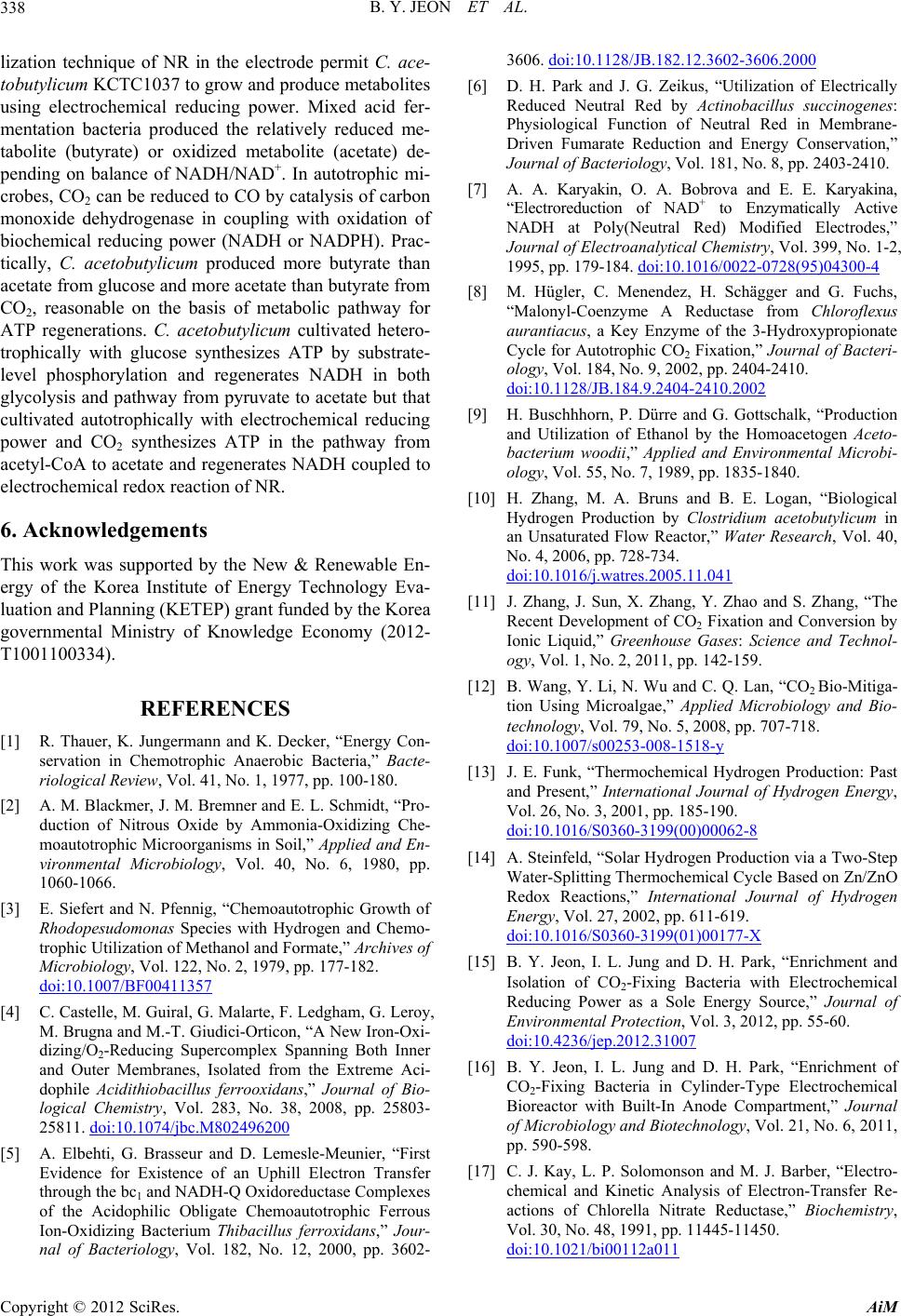
B. Y. JEON ET AL.
338
lization technique of NR in the electrode permit C. ace-
& Renewabl
ergy of the Korea Institute of Energy Technology
) grant funded by the Korea
. Jungermann and K. Decker, “Energy Con-
servation in Chemotrophic Anaerobic Bacteria,”
riological Rev, pp. 100-180.
, No. 2, 1979, pp. 177-182.
tobutylicum KCTC1037 to grow and produce metabolites
using electrochemical reducing power. Mixed acid fer-
mentation bacteria produced the relatively reduced me-
tabolite (butyrate) or oxidized metabolite (acetate) de-
pending on balance of NADH/NAD+. In autotrophic mi-
crobes, CO2 can be reduced to CO by catalysis of carbon
monoxide dehydrogenase in coupling with oxidation of
biochemical reducing power (NADH or NADPH). Prac-
tically, C. acetobutylicum produced more butyrate than
acetate from glucose and more acetate than butyrate from
CO2, reasonable on the basis of metabolic pathway for
ATP regenerations. C. acetobutylicum cultivated hetero-
trophically with glucose synthesizes ATP by substrate-
level phosphorylation and regenerates NADH in both
glycolysis and pathway from pyruvate to acetate but that
cultivated autotrophically with electrochemical reducing
power and CO2 synthesizes ATP in the pathway from
acetyl-CoA to acetate and regenerates NADH coupled to
electrochemical redox reaction of NR.
6. Acknowledgements
This work was supported by the New e En-
Eva-
luation and Planning (KETEP
governmental Ministry of Knowledge Economy (2012-
T1001100334).
REFERENCES
[1] R. Thauer, KBacte-
iew, Vol. 41, No. 1, 1977
[2] A. M. Blackmer, J. M. Bremner and E. L. Schmidt, “Pro-
duction of Nitrous Oxide by Ammonia-Oxidizing Che-
moautotrophic Microorganisms in Soil,” Applied and En-
vironmental Microbiology, Vol. 40, No. 6, 1980, pp.
1060-1066.
[3] E. Siefert and N. Pfennig, “Chemoautotrophic Growth of
Rhodopesudomonas Species with Hydrogen and Chemo-
trophic Utilization of Methanol and Formate,” Archives of
Microbiology, Vol. 122
doi:10.1007/BF00411357
[4] C. Castelle, M. Guiral, G. Malarte, F. Ledgham, G. Leroy,
M. Brugna and M.-T. Giudici-Orticon, “A New Iron-Oxi-
dizing/O2-Reducing Supercomplex Spanning Both
and Outer Membranes, Is
Inner
olated from the Extreme Aci-
dophile Acidithiobacillus ferrooxidans,” Journal of Bio-
logical Chemistry, Vol. 283, No. 38, 2008, pp. 25803-
25811. doi:10.1074/jbc.M802496200
[5] A. Elbehti, G. Brasseur and D. Lemesle-Meunier, “First
Evidence for Existence of an Uphill Electron Transfer
through the bc1 and NADH-Q Oxidoreductase Complexes
of the Acidophilic Obligate Chemoautotrophic Ferrous
Ion-Oxidizing Bacterium Thibacillus ferroxidans,” Jour-
nal of Bacteriology, Vol. 182, No. 12, 2000, pp. 3602-
3606. doi:10.1128/JB.182.12.3602-3606.2000
[6] D. H. Park and J. G. Zeikus, “Utilization of Electrically
Reduced Neutral Red by Actinobacillus succinogenes:
Physiological Function of Neutral Red in Membrane-
Driven Fumarate Reduction and Energy Conservation,”
Journal of Bacteriology, Vol. 181, No. 8, pp. 2403-2410.
[7] A. A. Karyakin, O. A. Bobrova and E. E. Karyakina,
“Electroreduction of NAD+ to Enzymatically Active
NADH at Poly(Neutral Red) Modified Electrodes,”
Journal of Electroanalytical Chemistry, Vol. 399, No. 1-2,
1995, pp. 179-184. doi:10.1016/0022-0728(95)04300-4
[8] M. Hügler, C. Menendez, H. Schägger and G. Fuchs,
“Malonyl-Coenzyme A Reductase from Chloroflexus
aurantiacus, a Key Enzyme of the 3-Hydroxypropionate
Cycle for Autotrophic CO2 Fixation,” Journal of Bacteri-
ology, Vol. 184, No. 9, 2002, pp. 2404-2410.
doi:10.1128/JB.184.9.2404-2410.2002
[9] H. Buschhhorn, P. Dürre and G. Gottschalk, “Production
and Utilization of Ethanol by the Homoacetogen Aceto-
bacterium woodii,” Applied and Environment
ology, Vol. 55, No. 7, 1989, pp. 1835-18
al Microbi-
40.
[10] H. Zhang, M. A. Bruns and B. E. Logan, “Biological
Hydrogen Production by Clostridium acetobutylicum in
an Unsaturated Flow Reactor,” Water Research, Vol. 40,
No. 4, 2006, pp. 728-734.
doi:10.1016/j.watres.2005.11.041
[11] J. Zhang, J. Sun, X. Zhang, Y. Zhao and S. Zhang, “The
Recent Development of CO2 Fixation and Conversion by
Ionic Liquid,” Greenhouse Gases
ogy, Vol. 1, No. 2, 2011, pp. 142-1
: Science and Technol-
59.
[12] B. Wang, Y. Li, N. Wu and C. Q. Lan, “CO2 Bio-Mitiga-
tion Using Microalgae,” Applied Microbiology and Bio-
technology, Vol. 79, No. 5, 2008, pp. 707-718.
doi:10.1007/s00253-008-1518-y
[13] J. E. Funk, “Thermochemical Hydrogen Production: Past
and Present,” International Journal of Hydrogen Energy,
Vol. 26, No. 3, 2001, pp. 185-190.
doi:10.1016/S0360-3199(00)00062-8
rnal of Hydrogen
[14] A. Steinfeld, “Solar Hydrogen Production via a Two-Step
Water-Splitting Thermochemical Cycle Based on Zn/ZnO
Redox Reactions,” International Jou
Energy, Vol. 27, 2002, pp. 611-619.
doi:10.1016/S0360-3199(01)00177-X
[15] B. Y. Jeon, I. L. Jung and D. H. Park, “Enrichment and
Isolation of CO2-Fixing Bacteria with Electrochemical
Reducing Power as a Sole Energy S
Environmental Protection, Vol. 3, 2012
ource,” Journal of
, pp. 55-60.
doi:10.4236/jep.2012.31007
[16] B. Y. Jeon, I. L. Jung and D. H. Park, “Enrichment of
CO2-Fixing Bacteria in Cylinder-Type Electrochemical
Bioreactor with Built-In Anode Compartment,” Jo
of Microbiology and Biotechnurnal
ology, Vol. 21, No. 6, 2011,
8, 1991, pp. 11445-11450.
pp. 590-598.
[17] C. J. Kay, L. P. Solomonson and M. J. Barber, “Electro-
chemical and Kinetic Analysis of Electron-Transfer Re-
actions of Chlorella Nitrate Reductase,” Biochemistry,
Vol. 30, No. 4
doi:10.1021/bi00112a011
Copyright © 2012 SciRes. AiM